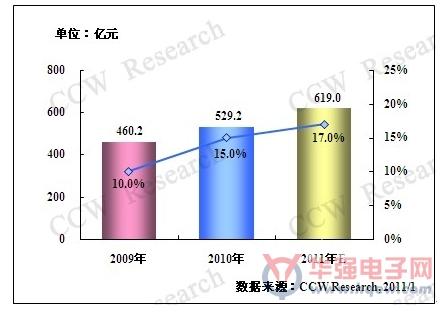 At the end of 2008, the international financial crisis originating from the United States led to a decline in China's exports. The decline in external demand has brought about an impact on the development of the Chinese manufacturing industry. This has directly caused a decline in the growth rate of IT investment in the manufacturing industry. Some industries even experienced negative growth in 2008 and 2009. . After nearly two years of adjustment, China's manufacturing companies finally emerged from adversity in 2010 and regained their vitality. Under the impetus of the new technology plan, IT investment growth returned to the second digit.
At the end of 2008, the international financial crisis originating from the United States led to a decline in China's exports. The decline in external demand has brought about an impact on the development of the Chinese manufacturing industry. This has directly caused a decline in the growth rate of IT investment in the manufacturing industry. Some industries even experienced negative growth in 2008 and 2009. . After nearly two years of adjustment, China's manufacturing companies finally emerged from adversity in 2010 and regained their vitality. Under the impetus of the new technology plan, IT investment growth returned to the second digit. CCW Research's 2011 China's Financial Industry Informatization and IT Application Trends Report pointed out that in 2009, the overall investment in manufacturing informatization reached 46.02 billion yuan. In 2010, the overall investment in manufacturing informatization reached 52.92 billion yuan. Yuan renminbi, a year-on-year increase of 15.0%. Basically restored to the level of growth prior to the international financial crisis in 2007, the market returned to double-digit normal growth levels. CCW Research believes that the absolute majority of Chinese manufacturing companies have completely shaken off the shadow of the financial crisis and began to emerge A new round of IT investment growth.
Chart 2009-2011 China Manufacturing Industry IT Investment Scale and Forecast Mining Secondary and even Third-level Fine-Molecules Industry has become the norm for market competition Since 2009, in response to the crisis, IT vendors have begun to subdivide deeper into each sub-sector of manufacturing companies. The opportunity to tap more sub-sectors has once become a new growth point for IT investment in the weak market. After two years of development, this kind of digging of deep market segments has become the norm. In other words, in 2010, the competition in the IT market of the manufacturing industry has entered a new stage, that is, the depth of the second level and even the third level in the traditional industry. Segmentation to capture market opportunities. For example, the machinery industry focuses on equipment manufacturing, general equipment manufacturing, industrial basic parts (pumps, concrete), special equipment (electrical equipment, agricultural machinery, medical equipment), plastics and other fine molecular industries. The focus of the electronics industry in 2010 is on basic components, LEDs, automotive electronics navigation, communications-related electronics applications, and consumer electronics. The automotive industry is driven by new technologies and innovations in automotive new energy and electric vehicle companies. It is driven by public utilities and infrastructure, as well as the basic engines, diesel engines, and automotive electronics. Opportunities in the textile and apparel industry are completely concentrated in self-owned brand enterprises. In addition, the distribution management system is becoming a hot spot for investment and construction of garment enterprises. Chemical industry, such as industrial basic raw materials, fine chemicals and pesticides and other agricultural chemicals are investment hotspots. The pharmaceutical industry is stimulated by the medical reform policy. After integrating the survival of the fittest, the pharmaceutical companies will have more development capabilities. The independent distribution system, distribution process management, dealer management and related systems construction will also become the focus of demand. Informatization investment in the food processing industry is still an industry opportunity that can be noticed. The steel industry is mainly focused on the reconstruction of large-scale smelting and mining enterprises after the merger and acquisition of small steel mills. The tobacco industry generates concentrated demand for system applications such as MES, supply chain management, and equipment management.
Technology promotion and business drive have become the two core drivers of IT investment growth in the new year. Transformation and upgrading of manufacturing companies have become a hot trend in 2010. The new competitive environment has made all manufacturing companies must take effective measures to ensure the sustainable development of enterprises. . Using e-commerce to broaden marketing methods, investing in IT systems to strengthen corporate risk control and cost management is the focus of various types and sizes of manufacturing companies in 2010. Manufacturing companies are learning lessons and actively thinking about the path of transformation, upgrading, and market exploration. Opportunity, finding new growth points. The popularity of cloud computing concepts, the application of virtualization on servers, the upgrading of enterprise IT architectures by SOA, the deepening of business intelligence, and the adoption of mobile applications and SaaS services. These new technologies have emerged as a means of promoting the development of Chinese manufacturing enterprises. At the right moment, technological advancements and business drivers became the two most important driving forces in the development of IT applications for manufacturing companies in 2010.
Lithium Battery Cr11108,Cell Lithium Battery,Lithium Button Cell Battery,Lithium Manganese Button Cell
Jiangmen Hongli Energy Co.ltd , https://www.honglienergy.com